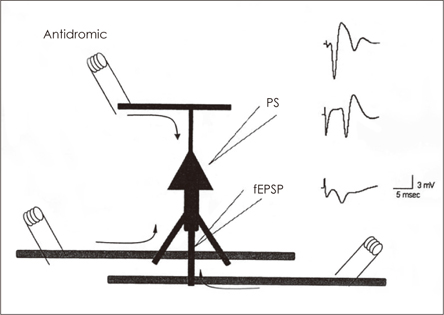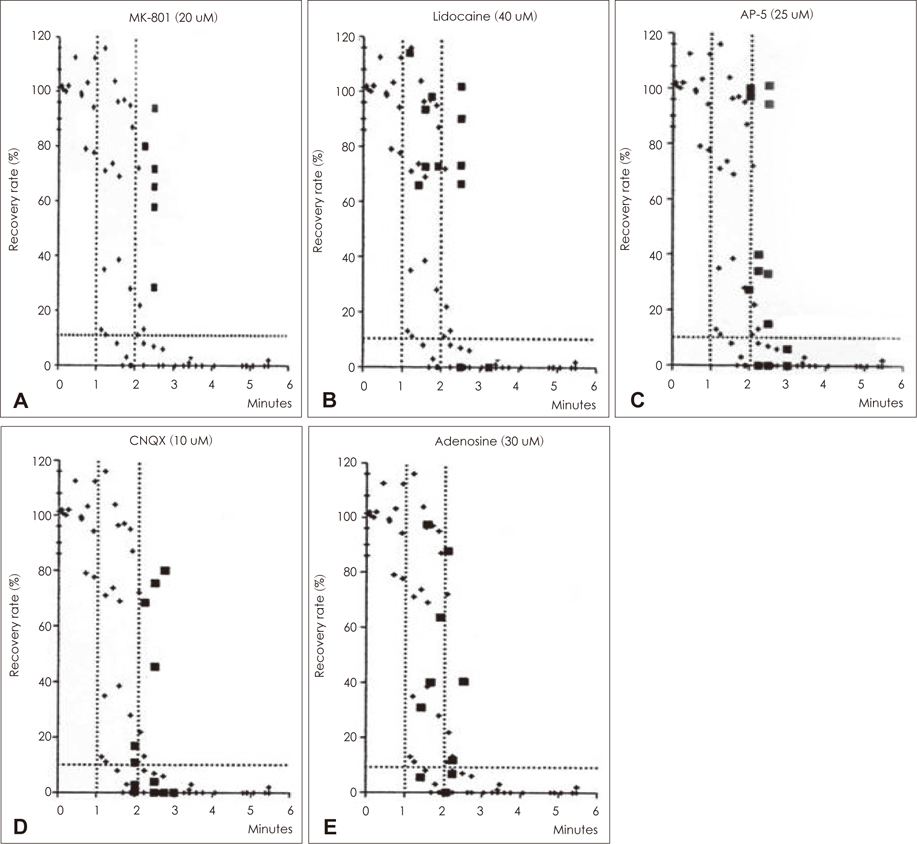J Korean Neurotraumatol Soc.
2011 Apr;7(1):1-7. 10.13004/jknts.2011.7.1.1.
Evaluating the Extent of Ischemic Insult on Hippocampal Slices by Using Antidromic Recordings
- Affiliations
-
- 1Department of Neurosurgery, Korea University Guro Hospital, Seoul, Korea. ykapa76@yahoo.co.kr
- KMID: 1427645
- DOI: http://doi.org/10.13004/jknts.2011.7.1.1
Abstract
OBJECTIVE
Energy failure and concurrent electrical silence are common features of oxygen-glucose deprivation (OGD) in the brain. Hippocampal slice has been used extensively to study electrophysiological alterations. Orthodromic extracellular field potential recording has been most widely chosen for those studies however there were few with antidromic recording. The goal of this study is to clarify which types of recordings is better for the evaluation of extent of ischecmic insults.
METHODS
Rat hippocampal slices were made for the orthodromically and antidromically evoked filed potential recording. Before, during and after 6 to 11 minutes of experimental OGD, the authors measured population spike amplitude and slope of field excitatory postsynaptic potential (fEPSP).
RESULTS
A dramatic reduction of amplitude and total disappearance of orthodromic population spike (oPS) noted 1.1 +/- 0.2 min after OGD onset. On the contrary antidromic population spike (aPS) was not affected at the beginning. It slowly and gradually diminished and finally disappeared 6.6 +/- 0.2 min after OGD onset. A transient recovery of oPS, so called hypoxic injury potentials (HIP) briefly occurred just before the total dissappearance of aPS and the both signals disappeared simultaneously. Incomplete recovery due to irreversible damage began 7 min after OGD onset. There was no recovery 10 min after OGD, 7 min after oPS loss and 2 min after aPS loss. The OGD experiments with various neuroprotective agents (MK 801, AP-5, lidocaine, CNQX, adenosine) lasted for longer than 2 min after aPS disappearance sensitively showed their efficacy.
CONCLUSION
These results show that observation for aPS after OGD provides more accurate timing of irreversible damage than those for oPS data or for the duration of OGD.
Keyword
MeSH Terms
Figure
Reference
-
1. Andersen P, Eccles JC, Loyning Y. Pathway of postsynaptic inhibition in the hippocampus. J Neurophysiol. 1964; 27:608–619.
Article2. Andersen P, Silfvenius H, Sundberg SH, Sveen O. A comparison of distal and proximal dendritic synapses on CAi pyramids in guinea-pig hippocampal slices in vitro. J Physiol. 1980; 307:273–299.3. Andersen P, Silfvenius H, Sundberg SH, Sveen O, Wigström H. Functional characteristics of unmyelinated fibres in the hippocampal cortex. Brain Res. 1978; 144:11–18.
Article4. Balestrino M, Aitken PG, Somjen GG. The effects of moderate changes of extracellular K+ and Ca2+ on synaptic and neural function in the CA1 region of the hippocampal slice. Brain Res. 1986; 377:229–239.
Article5. Cherubini E, Rovira C, Ben-Ari Y, Padjen A. Simultaneous recording of somatic and dendritic field potentials and combined microiontophoresis in the rat Ammon's horn in situ: effects of GABA and acetylcholine. Neurosci Lett. 1982; 31:19–24.
Article6. Corbett D, Nurse S. The problem of assessing effective neuroprotection in experimental cerebral ischemia. Prog Neurobiol. 1998; 54:531–548.
Article7. Danscher G, Shipley MT, Andersen P. Persistent function of mossy fibre synapses after metal chelation with DEDTC (Antabuse). Brain Res. 1975; 85:522–526.
Article8. de Mendonça A, Ribeiro JA. Adenosine inhibits the NMDA receptor-mediated excitatory postsynaptic potential in the hippocampus. Brain Res. 1993; 606:351–356.
Article9. de Mendonça A, Sebastião AM, Ribeiro JA. Inhibition of NMDA receptor-mediated currents in isolated rat hippocampal neurones by adenosine A1 receptor activation. Neuroreport. 1995; 6:1097–1100.
Article10. Doolette DJ, Kerr DI. Hyperexcitability in CA1 of the rat hippocampal slice following hypoxia or adenosine. Brain Res. 1995; 677:127–137.
Article11. Fairchild MD, Parsons JE, Wasterlain CG, Rinaldi PC, Wallis RA. A hypoxic injury potential in the hippocampal slice. Brain Res. 1988; 453:357–361.
Article12. Fowler JC. Adenosine antagonists alter the synaptic response to in vitro ischemia in the rat hippocampus. Brain Res. 1990; 509:331–334.
Article13. Jester JM, Campbell LW, Sejnowski TJ. Associative EPSP--spike potentiation induced by pairing orthodromic and antidromic stimulation in rat hippocampal slices. J Physiol. 1995; 484:689–705.
Article14. Klishin A, Lozovaya N, Krishtal O. A1 adenosine receptors differentially regulate the N-methyl-D-aspartate and non-N-methyl-D-aspartate receptor-mediated components of hippocampal excitatory postsynaptic current in a Ca2+/Mg(2+)-dependent manner. Neuroscience. 1995; 65:947–953.
Article15. McCullers DL, Sullivan PG, Scheff SW, Herman JP. Mifepristone protects CA1 hippocampal neurons following traumatic brain injury in rat. Neuroscience. 2002; 109:219–230.
Article16. Miyashita K, Nakajima T, Ishikawa A, Miyatake T. An adenosine uptake blocker, propentofylline, reduces glutamate release in gerbil hippocampus following transient forebrain ischemia. Neurochem Res. 1992; 17:147–150.
Article17. Niiyama S, Tanaka E, Yamamoto S, Yasumoto S, Kano T, Higashi H. Bupivacaine, but not tetracaine, protects against the in vitro ischemic insult of rat hippocampal CA1 neurons. Neurosci Res. 2002; 42:231–241.
Article18. Oliveira IJ, Molz S, Souza DO, Tasca CI. Neuroprotective effect of GMP in hippocampal slices submitted to an in vitro model of ischemia. Cell Mol Neurobiol. 2002; 22:335–344.19. Preston E, Webster J. Spectrophotometric measurement of experimental brain injury. J Neurosci Methods. 2000; 94:187–192.
Article20. Rekling JC. Neuroprotective effects of anticonvulsants in rat hippocampal slice cultures exposed to oxygen/glucose deprivation. Neurosci Lett. 2003; 335:167–170.
Article21. Schmidt-Kastner R, Truettner J, Lin B, Zhao W, Saul I, Busto R, Ginsberg MD. Transient changes of brain-derived neurotrophic factor (BDNF) mRNA expression in hippocampus during moderate ischemia induced by chronic bilateral common carotid artery occlusions in the rat. Brain Res Mol Brain Res. 15; 92(1-2):157–166.
Article22. Sebastião AM, de Mendonca A, Moreira T, Ribeiro JA. Activation of synaptic NMDA receptors by action potential-dependent release of transmitter during hypoxia impairs recovery of synaptic transmission on reoxygenation. J Neurosci. 2001; 21:8564–8571.
Article23. Shinskaia NE. [Role of cAMP in regulating hippocampal neuronal reactivity in vitro]. Biull Eksp Biol Med. 1982; 94:3–5.24. Swanson TH, Drazba JA, Rivkees SA. Adenosine A1 receptors are located predominantly on axons in the rat hippocampal formation. J Comp Neurol. 1995; 363:517–531.
Article
- Full Text Links
- Actions
-
Cited
- CITED
-
- Close
- Share
- Similar articles
-
- The Protective Effect of Preconditioning Ischemia on Subsequent Cerebral Ischemic Insults
- The protective effect of Cortical Infarction to the Neuronal damage following subsequent global ischemic insult in gebril
- Changes of 5-hydroxytryptamine release by different glucose concentration from hippocampal slices exposed to hypoxia
- Glucose/oxygen deprivation induces release of (3H)5-hydroxytryptamine associated with synapsin 1 expression in rat hippocampal slices
- Estrogen Pretreatment of Organotypic Hippocampal Slices Protects Neurons against Oxygen-Glucose Deprivation with Akt Activation





